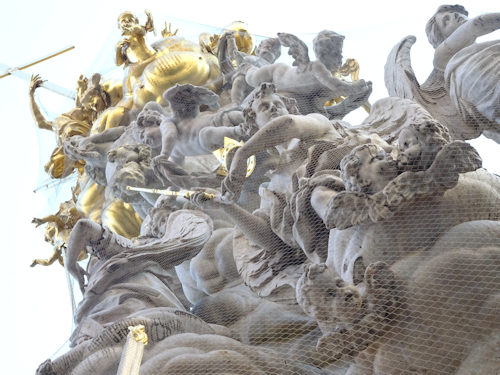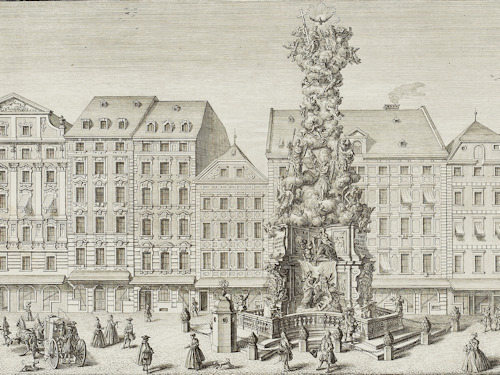
In the absence of antibiotics, what’s a 17th-century city to do when the plague sweeps across Europe? Put up a few statues and trust to providence it would seem.
- Detailed decorated column erected around 1690
- A Viennese landmark on the pedestrianised Graben
- Look for the (in)famous protruding Habsburg lip on a lower relief
- Book a two-hour walking tour* for your trip
- See also:
Pestsäule history

(A view down the Graben with the Pestsäule on the left. Given the lack of pedestrians, I must have got up alarmingly early for this photo)
Life is rarely relaxed when your next visitor might bring thousands of friends waving swords and pitchforks.
So you can hardly blame the 17th-century Viennese for trying everything to get a bit of higher authority on their side. Just in case they ever needed divine help.
In 1679, for example, one particularly unwelcome visitor was Yersinia pestis, better known as the bacteria that causes the plague.
To help ward off the epidemic, the authorities built a wooden Pestsäule (pest column) on the Graben in Vienna’s centre.

(Clouds of angels up the column)
This Pestsäule drew its inspiration from the tradition of Marian or Holy Trinity columns.
These columns were topped by the Virgin Mary or a representation of the Holy Trinity. People typically erected them as a declaration of faith or out of gratitude for surviving some dramatic event, like a war.
Of course, large columns of this nature also did no harm for the self-esteem and image of the sponsor, adding another tick in their book of good deeds.
This wooden Pestsäule went up while the plague still raged through the city, but the Emperor of the time (Leopold I) committed himself to building a more durable alternative, presumably to give thanks for the eventual end of the epidemic.

(View of the Pestsäule as drawn by Salomon Kleiner, engraved by Johann August Corvinus and published by Johann Andreas d. Ä. Pfeffel in 1733; Wien Museum Inv.-Nr. 95077/79; excerpt reproduced with permission under the terms of the CC0 licence)
Incidentally, Leopold didn’t hang around to lend much moral support to his suffering subjects. He fled the city, returning only when the all clear was given. Not the only time he ever did a runner: Leopold also abandoned Vienna before the 1683 siege by the Ottoman empire.
(Not even monarchs are safe from fate’s eye for a touch of irony, however. The plague “followed” Leopold to Prague.)
The plague column itself
The first designer of the new, permanent Pestsäule (Matthias Rauchmiller) died in 1686 before too much progress could be made.

(View of the lower level)
Various sculptors and others then became involved with the further development and construction, including a certain Johann Bernhard Fischer von Erlach, the architect responsible for such iconic Viennese buildings as Schönbrunn Palace, the Spanish Riding School, or the Karlskirche church.
As a dedication to the Holy Trinity, the number three or multiples of three play a strong role throughout the column.
For example, the design involves three vertical layers: the first human, then angels, then the Holy Trinity itself. You’ll also see the Pestsäule has three wings, nine large angels, three bronze scrolls, etc.
Look for the Emperor himself on the most open side, easily identified by the protruding lower lip: a facial characteristic common to the Habsburg dynasty.

(Emperor Leopold I)
Even today, this medical condition (mandibular prognathism) is known as Habsburg Jaw.
How to get to the plague column
If you’re in Vienna for longer than around 5 minutes, you’ll likely find yourself wandering down the pedestrianised Graben. This street runs between Stephansdom cathedral and the east side of the Hofburg palace complex. The plague column sits about half way along: you can’t miss it.
While there, check out two buildings opposite: the famous architect, Otto Wagner, built both the Ankerhaus and Grabenhof.
Alternatively, take a trip to just outside the city and Klosterneuburg Abbey. The treasury there includes a gorgeous 1679 silver filigree model of the original plague column.
Address: Graben, 1010 Vienna